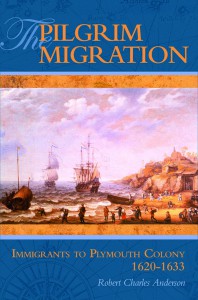 Thanksgiving is a holiday that prompts many of us to imagine, based on the history we’ve learned from childhood, what it was really like at the first Thanksgiving in 1621. It’s a story all Americans share, regardless of whether our ancestors were already living here in 1620, were among those who arrived on the Mayflower, or were counted as part of the multitude that followed in the coming decades and centuries, for Plymouth Colony set the stage for the America in which we now live.
Thanksgiving is a holiday that prompts many of us to imagine, based on the history we’ve learned from childhood, what it was really like at the first Thanksgiving in 1621. It’s a story all Americans share, regardless of whether our ancestors were already living here in 1620, were among those who arrived on the Mayflower, or were counted as part of the multitude that followed in the coming decades and centuries, for Plymouth Colony set the stage for the America in which we now live.
If your ancestors arrived in that early 1620 to 1640 period – taking part in those earliest of Thanksgiving celebrations – it’s likely they have been cited in Robert Charles Anderson’s Great Migration Study Project, which covers the migration from England in two book series and two complementary books.
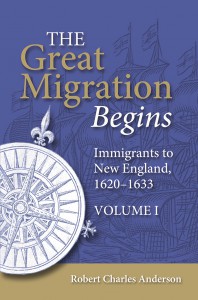 The first series, the three-part Great Migration Begins, covers more than 900 families who settled in New England between 1620 and 1633. Among many other vital pieces of information, these sketches include marriages, births, deaths, and other important family relationships. The companion Pilgrim Migration tells the story of every family or individual known to have resided in Plymouth Colony during that time. Anderson incorporates background on the colonists’ New World experiences, giving us more clues as to how the earliest settlers lived.
The first series, the three-part Great Migration Begins, covers more than 900 families who settled in New England between 1620 and 1633. Among many other vital pieces of information, these sketches include marriages, births, deaths, and other important family relationships. The companion Pilgrim Migration tells the story of every family or individual known to have resided in Plymouth Colony during that time. Anderson incorporates background on the colonists’ New World experiences, giving us more clues as to how the earliest settlers lived.
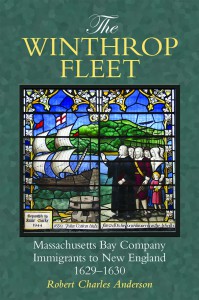 Anderson also addresses the small 1630 armada headed by John Winthrop, who led hundreds of Puritans and a fleet of more than a dozen ships from England to the New World. The Winthrop Fleet describes the 1629 and 1630 migration to New England as organized and directed by the Massachusetts Bay Company, supplementing The Great Migration Begins with more than 200 genealogical and biographical sketches of Winthrop Fleet immigrants.
Anderson also addresses the small 1630 armada headed by John Winthrop, who led hundreds of Puritans and a fleet of more than a dozen ships from England to the New World. The Winthrop Fleet describes the 1629 and 1630 migration to New England as organized and directed by the Massachusetts Bay Company, supplementing The Great Migration Begins with more than 200 genealogical and biographical sketches of Winthrop Fleet immigrants.
The second full series of books, The Great Migration, is a seven-volume work that profiles more than 1,400 early New England immigrants during 1634–1635. These two watershed years of New England immigration represent as much as 20% of the total for the entire era. (Yes, that’s seven volumes covering two years!)
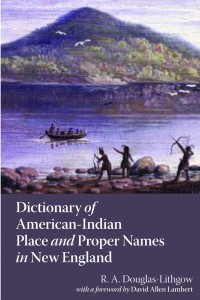 It’s hard to imagine that the steady influx of English immigrants would have continued were it not for the help of the peoples already living and thriving in what became New England. One book that takes readers back to pre-1620 New England is R. A. Douglas-Lithgow’s Dictionary of American-Indian Place and Proper Names in New England. NEHGS Senior Genealogist David Allen Lambert says that this book “offers insight into a rich and fascinating culture whose history is largely unwritten.”
It’s hard to imagine that the steady influx of English immigrants would have continued were it not for the help of the peoples already living and thriving in what became New England. One book that takes readers back to pre-1620 New England is R. A. Douglas-Lithgow’s Dictionary of American-Indian Place and Proper Names in New England. NEHGS Senior Genealogist David Allen Lambert says that this book “offers insight into a rich and fascinating culture whose history is largely unwritten.”
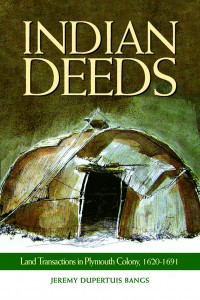 And of course the issue of land transfer cannot be overlooked in understanding early colonial life. In Indian Deeds: Land Transactions in Plymouth Colony 1620-1691, author Jeremy Dupertuis Bangs offers a re-evaluation of land ownership and the relations between early-seventeenth-century European settlers and their Indian neighbors. The book – of interest to Mayflower, Plymouth Colony, and Native American researchers – provides more than 400 transcriptions of early deeds.
And of course the issue of land transfer cannot be overlooked in understanding early colonial life. In Indian Deeds: Land Transactions in Plymouth Colony 1620-1691, author Jeremy Dupertuis Bangs offers a re-evaluation of land ownership and the relations between early-seventeenth-century European settlers and their Indian neighbors. The book – of interest to Mayflower, Plymouth Colony, and Native American researchers – provides more than 400 transcriptions of early deeds.
Although we’ll never have photos or home movies of the earliest Thanksgivings, such genealogical resources as these help us imagine in greater detail!
Share this:
About Leslie Ann Weston
Leslie came to NEHGS with more than 25 years experience in book publishing. Skilled in both editing and book production, she has coordinated the publication of, among other titles, The Nelson Family of Rowley, Massachusetts, and Ancestors and Descendants of George Rufus Brown and Alice Nelson Pratt.View all posts by Leslie Ann Weston →